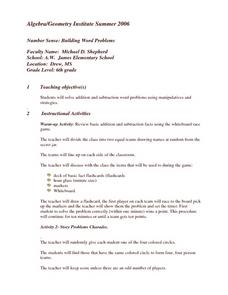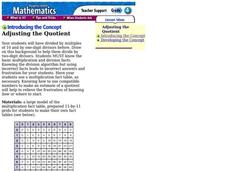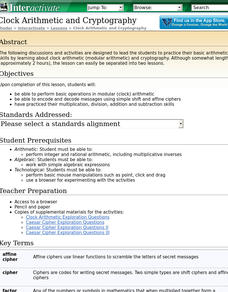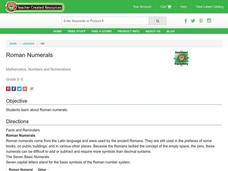Curated OER
Factor Fun for Fifth Graders
Fifth graders explore common factors. In this factorization instructional activity, 5th graders discover the greatest common factor among two numbers in a game format. Students build on previous knowledge to determine the greatest common...
Curated OER
Relationship Between Addition and Subtraction
Young scholars are taught how to add and subtract and use number sense to solve basic math problems. In this addition and subtraction lesson, students are being taught using theories from different philosophers in education. They are...
Curated OER
Three-Digit Addition and Subtraction With Regrouping
Second graders access prior knowledge of addition and subtraction using two-digit numbers and calculate easily with them. In this three-digit addition lesson, 2nd graders learn to add and subtract three-digit numbers with and without...
Curated OER
Building Word Problems
Sixth graders study addition and subtraction facts. In equal groups, they play a race game to correctly solve addition and subtraction problems. Using a PowerPoint presentation, the teacher demonstrates how to write word problems and...
Curated OER
Writing a Number Sentence
Third graders analyze word problems. In this number sentence lesson, 3rd graders evaluate word problems. Students create number sentences from word problems.
Curated OER
Ten Little Black Dots
Second graders use black and red construction paper to symbolize different one digit numbers that add up to 10. In this sums to 10 lesson plan, 2nd graders discover different combinations and patterns that can lead them to the number 10.
Curated OER
Adding and Subtracting With Negative Numbers
Fifth graders access prior knowledge of calculating using a number line. In this adding and subtracting with negative numbers lesson plan, 5th graders use a number line to solve math problems.
Curated OER
Asteroids
Students study asteroids and how their size relates to a possible danger of one colliding with Earth. In this asteroids lesson students see how big an asteroid has to be to cause destruction to Earth.
Curated OER
Calculate the Answer
Students solve basic multiplication or addition facts using a calculator and product cards. They draw a card, read the sum or product, and press single digits on the calculator to display the number on the card.
Curated OER
THE TRAVELS OF BABAR: An Adventure in Scale :Building a Model Hot Air Balloon
Students encounter basic facts about helium and hot air. They compare the weight and size of different materials. Students work collaboratively in teams. They create their own model balloon.
Curated OER
Clock Arithmetic and Cryptography
Students perform basic operations in modular (clock) arithmetic. Students encode and decode messages using shift and affine ciphers. Students apply their multiplication, division, addition, and subtraction skills.
EngageNY
Review of the Assumptions (part 1)
What was the property again? Tired of hearing this from your pupils? Use this table to organize properties studied and as a reference tool for individuals. Learners apply each property in the third column of the table to ensure their...
Curated OER
Adjusting the Quotient
Fourth graders use number facts to estimate quotients. In this division lesson, 4th graders examine long division problems to determine which multiple of ten will help them determine a number that is close to a quotient. They adjust the...
EngageNY
Properties of Parallelograms
Everyone knows that opposite sides of a parallelogram are congruent, but can you prove it? Challenge pupils to use triangle congruence to prove properties of quadrilaterals. Learners complete formal two-column proofs before moving on to...
Curated OER
FREE STANDING STRUCTURE
Students demonstrate basic construction skills by building a free standing structure. They compute the cost of the structure.
Curated OER
Pascal's Triangle
Students study Pascal's triangle. They construct their own version of Pascal's triangle, and relate some of the uses for it. While working through this process, students practice their integer multiplication and division skills.
Curated OER
Probability & Game Theory
Students explore the concept of probability. In this probability lesson plan, students perform various probability experiments including flipping a coin, picking m&m's out of a bag, and the birthday problem.
Curated OER
Clock Arithmetic and Cryptography
Students investigate modular clock arithmetic and cryptography. They perform basic operations in modular (clock) arithmetic and encode and decode messages using simple shift and affine ciphers.
Curated OER
Roman Numerals
Students explore the concept of Roman numerals. They investigate the seven basic numerals and the symbols that are used in the Roman numeral system and their values. Students practice converting Roman numerals.
Curated OER
Probability and Statistics
Students are taught to search the internet for statistics concepts on sports. In this probability lesson, students collect data and use the calculator to graph and analyze their data. They graph and make predictions about sports using...
Curated OER
Less is More: Subtraction in Action
Students participate in group games to help review the concept of subtraction. During the games, they practice subtracting two-digit numbers and the concept of borrowing. They review their answers with the class and move on to...
Curated OER
Clock Arithmetic and Cryptography
Students explore the concept of modular arithmetic and cryptography. For this modular arithmetic and cryptography lesson, students use applets to explore modular arithmetic using a clock and Caesar Ciphers. Students exchange their...
Curated OER
How to Use the Distributive Property of Multiplication
Fourth graders evaluate the distributive property of multiplication. In this multiplication lesson, 4th graders discover how the distributive property makes problem solving faster. Students complete several problems demonstrating their...
Curated OER
Hands On: Model Division
In this division worksheet, students use counters to solve 6 problems pertaining to basic division facts. These are story problems.

























